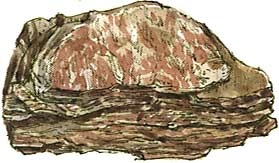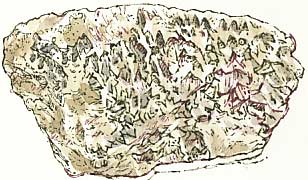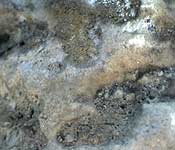
 SILTSTONE fills the gap in texture between sandstone and mudstone. This stone from the river cliff at Langsett (see yesterday's diary) feels slightly rough but my microscope on 10x (right) shows that it has very fine grains.
SILTSTONE fills the gap in texture between sandstone and mudstone. This stone from the river cliff at Langsett (see yesterday's diary) feels slightly rough but my microscope on 10x (right) shows that it has very fine grains.Wild West Yorkshire, Saturday 6 November 2010
previous | this month | next

 SILTSTONE fills the gap in texture between sandstone and mudstone. This stone from the river cliff at Langsett (see yesterday's diary) feels slightly rough but my microscope on 10x (right) shows that it has very fine grains.
SILTSTONE fills the gap in texture between sandstone and mudstone. This stone from the river cliff at Langsett (see yesterday's diary) feels slightly rough but my microscope on 10x (right) shows that it has very fine grains.
Sandstone was laid down as beds of sand in fairly fast-flowing water - a high energy environment - mudstone, also known as shale, in layers in still waters - a low energy environment. Silt comes in between, I think of it as the sort of deposit you'd get when a river periodically floods. There are seven layers in this piece which you could easily prize apart. Each one represents a pulse of sediment, perhaps deposited in a flooding event.
At the start of each flood the current would be at its fastest and it would slacken off as the flood started to subside, so you'd get graded grains of sediment. The next flood would again start by depositing the coarser sediment before it in turn slackened off. This explains why the layers aren't quite homogenous and why the rock splits along the bedding planes between finer and coarser sediment.

 Flowstone is deposited by water flowing in a thin sheet. If it was dripping continuously in one particular spot it would form stalactites or stalagmites.
Flowstone is deposited by water flowing in a thin sheet. If it was dripping continuously in one particular spot it would form stalactites or stalagmites.
Magnesian limestone aggregate has been laid down on track for the forestery operations at Langsett reservoir. It is cream coloured and uniform in texture. It was laid down about 270 to 250 million years ago as the supercontinent Pangaea came together at the start of the Permian period.. Magnesian limestone contains dolomite, a double carbonate of calcium and magnesium. I always think of it as being laid down in a 'dying sea' - in the Zechstein Sea which stretched as far as present-day Poland - but of course the sea came and went in cycles so it wasn't 'dying' during that whole period.
Even so, fossils are rare in magnesian limestone. Scanning the ground as I walked along I found a few chunks which had a stippled texture on one side. I did think that they just might be some kind of colonial animal such as a coral but this piece shows the true origin of the texture as you can see a direction to the flow. Under a microscope (right) you can see a difference in colour and texture between the redeposited whitish lime and the greyer, ashy-looking matrix.
After the limestone had formed, this flowstone would have been deposited in joints - vertical cracks - that developed in the horizontal beds.
Richard Bell, illustrator
previous | this month | Wild West Yorkshire home page | next